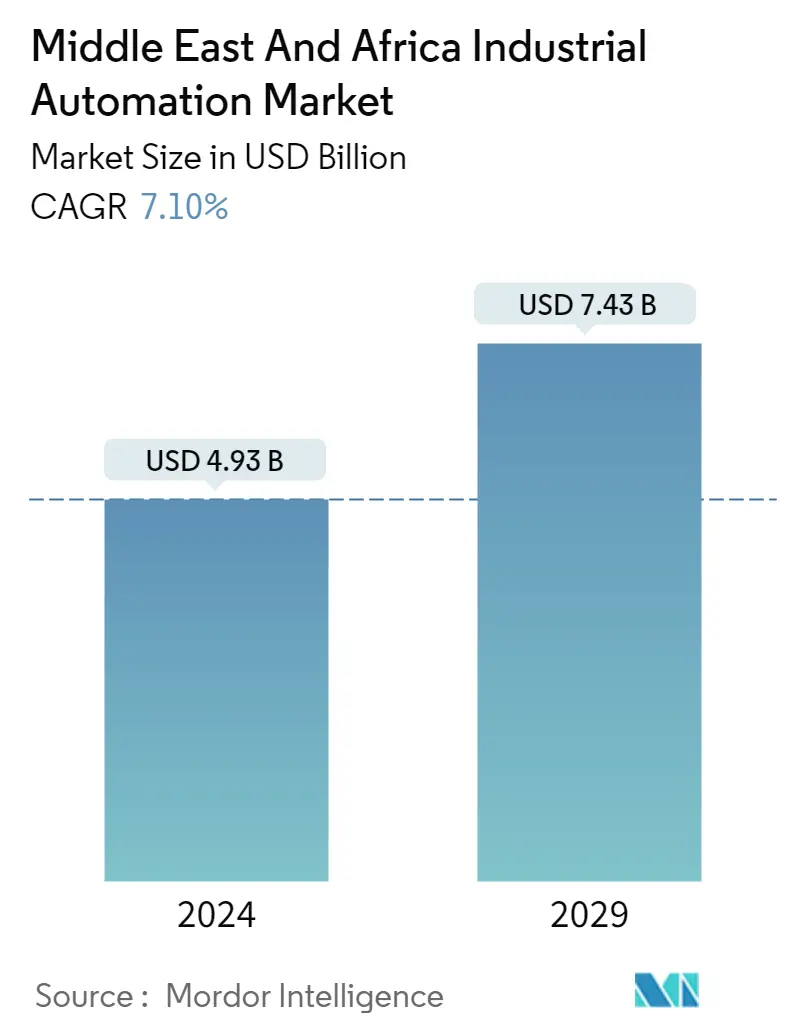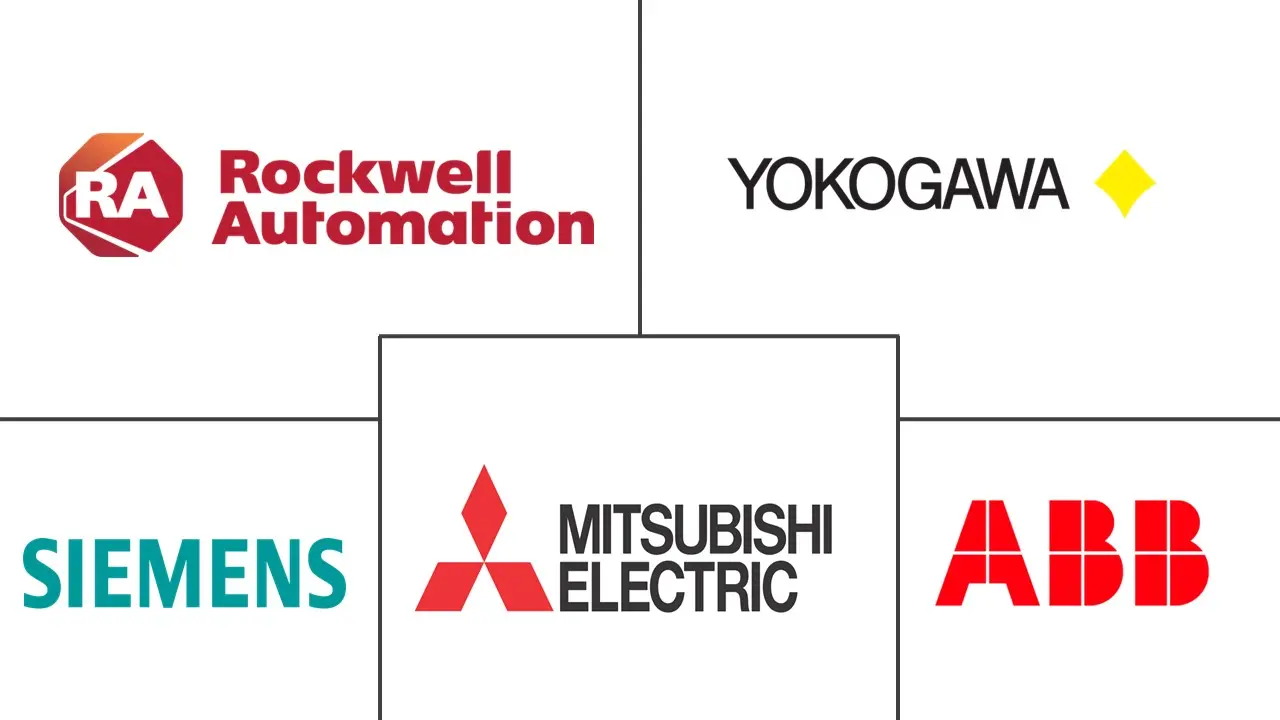Market Size of Middle East And Africa Industrial Automation Industry

| Study Period | 2019 - 2029 |
| Base Year For Estimation | 2023 |
| Market Size (2024) | USD 4.93 Billion |
| Market Size (2029) | USD 7.43 Billion |
| CAGR (2024 - 2029) | 7.10 % |
| Market Concentration | Medium |
Major Players
*Disclaimer: Major Players sorted in no particular order |
Middle East And Africa Industrial Automation Market Analysis
The Middle East And Africa Industrial Automation Market size is estimated at USD 4.93 billion in 2024, and is expected to reach USD 7.43 billion by 2029, growing at a CAGR of 7.10% during the forecast period (2024-2029).
The growing active collaboration between governments, regulators, and associations for economic expansion is one of the primary aspects driving growth in the region's automation and manufacturing sectors. For instance, in May 2022, RX Africa announced the Future Manufacturing Africa Trade Fair and Summit 2023, exchanging valuable industry expertise to increase investment prospects in the African continent's manufacturing sector.
- The UAE Government is focused on doubling the contribution of industrial manufacturing to the country's GDP to 25%, as highlighted in Dubai Industrial Strategy 2030 and Abu Dhabi Economic Vision 2030. Operation 300bn is a government strategy aimed at developing the industrial sector and enhancing its role in stimulating the economy of the UAE. It aims to increase the industrial sector's contribution to the GDP to AED 300 billion (~USD 82 billion) by 2031.
- Furthermore, the Emirates Development Bank (EDB) is a crucial enabler of Operation 300bn. Under the strategy, the bank has allocated AED 30 billion to support priority industrial sectors over five years. Such investments are expected to boost the industrial sector's demand for automated material handling.
- Moreover, rising technological advancements support market growth. In addition, the UAE Ministry of Industry and Advanced Technology and Abu Dhabi defense technology company Edge Group signed an agreement in August 2022 to develop the Emirates' first Industry 4.0 Enablement Centre. The center will help manufacturers beef up their operations by guiding them on using automation, and data-driven business expansion will further drive market growth.
- In February 2022, to fulfill the increased demand for conveying systems in the region, Dubai-based Acme Intralog, a provider of industrial and warehouse automation solutions, stated that it had enhanced the fabrication and manufacturing capabilities of conveyor belts used at its plant in the UAE. The company provides comprehensive conveyor belt solutions for various business sectors, including food and beverage, construction, packaging, textile, and material handling.
- Furthermore, the UAE intends to increase its power generation capacity by approximately 21 GW, with solar power accounting for 26.1% of the total additional generation capacity. These infrastructure developments will likely provide solutions for industrial controls and factory automation.
- However, a higher initial investment cost involved with industrial automation solutions continues to challenge the studied market's growth, especially in the African region, wherein price sensitivity is higher.
- Inflation has a significant impact on industrial manufacturing, as it can lead to higher costs for manufacturers. This can be due to various factors, such as higher prices for raw materials, increased shipping costs, and labor costs and shortages. As a result, manufacturers may be forced to raise their prices to maintain profitability, which can ultimately lead to decreased demand for their products. In addition, inflation can also lead to contract constraints, shifts in labor, and input issues for manufacturers, impacting the studied market's growth.
Middle East And Africa Industrial Automation Industry Segmentation
Industrial automation refers to utilizing control systems, including computers or robots, and information technologies to handle different industrial processes and machinery replacing human beings. Industrial automation marks the second step after mechanization in the direction of industrialization.
The Middle East and Africa industrial automation market is segmented by solution type (automated material handling solutions (conveyor/sortation systems, automated storage and retrieval systems (AS/RS), mobile robots (automated guided vehicles and autonomous mobile robots), automatic identification and data capture (AIDC), warehouse management systems (WMS)/warehouse control systems (WCS)), factory automation solutions (industrial control Systems (DCS, PLC, SCADA, HMI, etc.), field devices, industrial robotics, sensors, and transmitters, Motors, and drives) and end-user (automated material handling market (manufacturing, non-manufacturing (warehouses/distribution centers/logistics centers), general merchandise, healthcare, FMCG/non-durable goods), factory automation market, food and beverage, pharmaceuticals, durable manufacturing, textiles).
The market sizes and forecasts are provided in terms of value (USD) for all the above segments.
| By Solution Type | ||||||||
| ||||||||
|
| By End Users | ||||||||
| ||||||||
|
| By Country | |
| United Arab Emirates | |
| Saudi Arabia | |
| South Africa | |
| Rest of the Middle East |
Middle East And Africa Industrial Automation Market Size Summary
The Middle East and Africa industrial automation market is poised for significant growth, driven by strategic government initiatives and technological advancements. In the UAE, efforts such as the Dubai Industrial Strategy 2030 and Abu Dhabi Economic Vision 2030 aim to significantly boost the industrial sector's contribution to the national GDP. The Operation 300bn strategy, supported by the Emirates Development Bank, is set to enhance the industrial sector's role in the UAE's economy, fostering demand for automated solutions. Additionally, the establishment of the Industry 4.0 Enablement Centre and advancements in conveyor belt manufacturing underscore the region's commitment to integrating automation across various sectors. However, the high initial investment costs and inflationary pressures present challenges, particularly in Africa, where price sensitivity is more pronounced.
In the oil and gas sector, automation is becoming increasingly essential for enhancing operational efficiency and safety, particularly in exploration and production activities. The Middle East's substantial oil reserves and ongoing exploration activities, such as those by ADNOC, drive demand for industrial automation solutions. Saudi Arabia's focus on diversifying its economy through initiatives like Saudi Vision 2030 is fostering growth in manufacturing, e-commerce, and logistics, further propelling the automation market. The presence of major automation solution providers and new market entrants is intensifying competition, with companies like Schneider Electric and Honeywell expanding their regional manufacturing capabilities. These developments, coupled with strategic investments in advanced technologies, are expected to sustain the market's growth trajectory over the forecast period.
Middle East And Africa Industrial Automation Market Size - Table of Contents
-
1. MARKET INSIGHTS
-
1.1 Market Overview
-
1.2 Industry Attractiveness - Porters Five Forces Analysis
-
1.2.1 Bargaining Power of Suppliers
-
1.2.2 Bargaining Power of Buyers
-
1.2.3 Threat of New Entrants
-
1.2.4 Threat of Substitutes
-
1.2.5 Intensity of Competitive Rivalry
-
-
1.3 Industry Value Chain Analysis
-
1.4 Impact of Macro Economic trends on the market
-
-
2. MARKET SEGMENTATION
-
2.1 By Solution Type
-
2.1.1 Automated Material Handling Solutions
-
2.1.1.1 Conveyor/Sortation Systems
-
2.1.1.2 Automated Storage and Retrieval System (AS/RS)
-
2.1.1.3 Mobile Robots (Automated Guided Vehicles and Autonomous Mobile Robots)
-
2.1.1.4 Automatic Identification and Data Capture (AIDC)
-
2.1.1.5 Warehouse Management Systems (WMS)/Warehouse Control System (WCS)
-
-
2.1.2 Factory Automation Solutions
-
2.1.2.1 Industrial Control Systems (DCS, PLC, SCADA, HMI, etc.)
-
2.1.2.2 Field Devices
-
2.1.2.3 Industrial Robotics
-
2.1.2.4 Sensors and Transmitters
-
2.1.2.5 Motors and Drives
-
2.1.2.6 Others
-
-
-
2.2 By End Users
-
2.2.1 Automated Material Handling Market
-
2.2.1.1 Manufacturing
-
2.2.1.2 Non-Manufacturing (Warehouses/Distribution Centers/ Logistics Centers)
-
2.2.1.3 General Merchandise
-
2.2.1.4 Healthcare
-
2.2.1.5 FMCG/Non-durable Goods
-
2.2.1.6 Other End Users (Fashion, Durable Goods, and Post and Parcel)
-
-
2.2.2 Factory Automation Market
-
2.2.2.1 Food and Beverage
-
2.2.2.2 Pharmaceuticals
-
2.2.2.3 Durable Manufacturing
-
2.2.2.4 Textiles
-
2.2.2.5 Other End Users (Pulp and Paper, Water and Wastewater, Chemicals, and Oil and Gas)
-
-
-
2.3 By Country
-
2.3.1 United Arab Emirates
-
2.3.2 Saudi Arabia
-
2.3.3 South Africa
-
2.3.4 Rest of the Middle East
-
-
Middle East And Africa Industrial Automation Market Size FAQs
How big is the Middle East And Africa Industrial Automation Market?
The Middle East And Africa Industrial Automation Market size is expected to reach USD 4.93 billion in 2024 and grow at a CAGR of 7.10% to reach USD 7.43 billion by 2029.
What is the current Middle East And Africa Industrial Automation Market size?
In 2024, the Middle East And Africa Industrial Automation Market size is expected to reach USD 4.93 billion.

